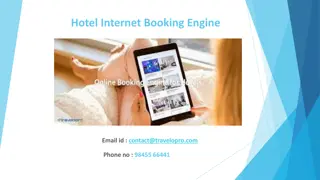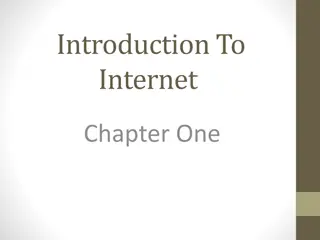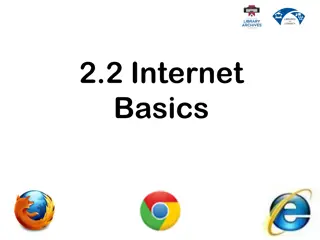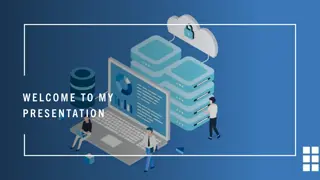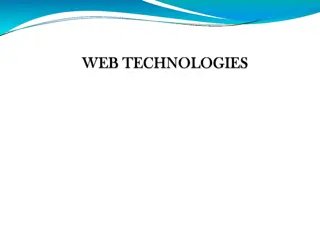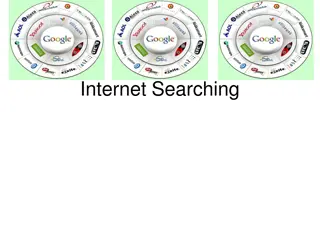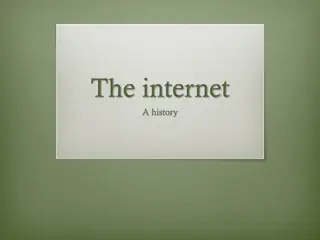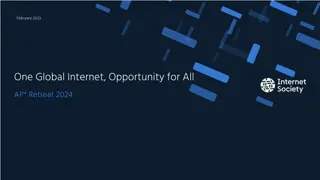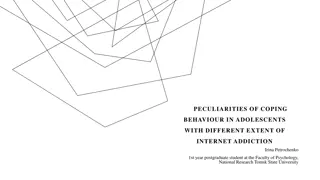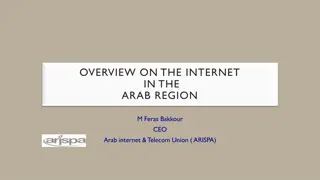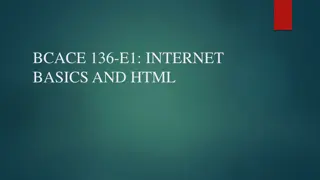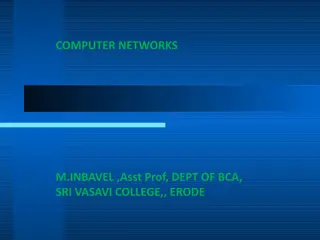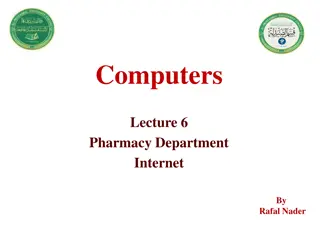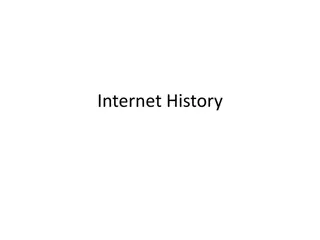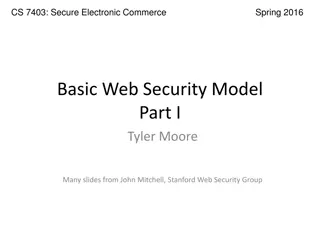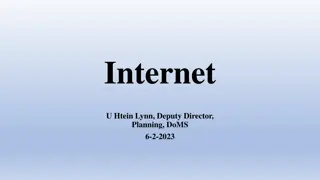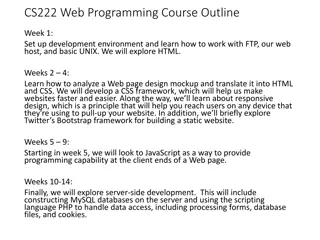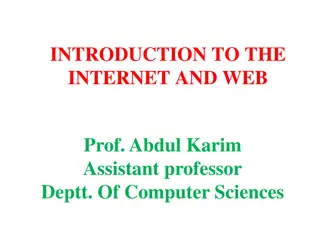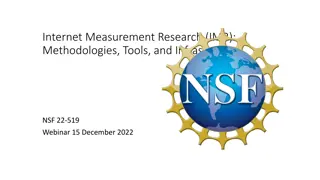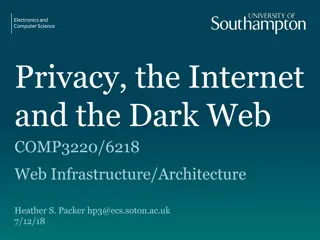Difference Between Internet and Web: Explained
The Internet and the web are often mistaken for each other, but they serve different purposes. The Internet is a global network of interconnected devices, while the web is a multimedia interface that allows access to resources. Learn more about their distinctions and evolution through the various web generations.
Download Presentation

Please find below an Image/Link to download the presentation.
The content on the website is provided AS IS for your information and personal use only. It may not be sold, licensed, or shared on other websites without obtaining consent from the author.If you encounter any issues during the download, it is possible that the publisher has removed the file from their server.
You are allowed to download the files provided on this website for personal or commercial use, subject to the condition that they are used lawfully. All files are the property of their respective owners.
The content on the website is provided AS IS for your information and personal use only. It may not be sold, licensed, or shared on other websites without obtaining consent from the author.
E N D
Presentation Transcript
I S H I K U N I V E R S I T Y FA C U LT Y O F S C I E N C E D E P. O F I N F O R M AT I O N T E C H N O L O G Y B Y: PAYA M WA L I
OUT LINE Internet and the web Web generations Whats the difference between ineternet and the web ? Internet access. 2 . .
INTERNET AND THE WEB The Internet was launched in 1969 when the United States funded a project that developed a national computer network called Advanced Research Project Agency Network (ARPANET). It was designed to connect military research centers The Internet is a large network that connects together smaller networks all over the globe. The web, also known as the World Wide Web or WWW, was introduced in 1991. Prior to the web, the Internet was all text no graphics, animations, sound, or video. The web made it possible to include these elements. It provided a multimedia interface to resources available on the Internet. 3 . .
TYPES OF WEBSITE CONTENT 1. 2. Static Web Site Dynamic Web Site 4 .
5 .
6 .
7 .
WEB GENERATIONS The first generation of the web, known as Web 1.0, focused on linking existing information. In this generation search programs, like Google Search, were created to provide links to websites containing specific words or phrases. In 2001, the second generation, Web 2.0, evolved to support more dynamic content creation and social interaction. Facebook is one of the best-known Web 2.0 applications. Web 3.0 is the current generation. It focuses on applications that automatically prepare personalized content for users. For example, Google Now uses data from the web (e.g., an individual s calendar of planned activities, weather reports, traffic reports, etc.), searches for interrelationships among the data (e.g., the effect of weather and traffic on an individual s planned daily commute to work), and automatically presents relevant information to the user (e.g., sends an early morning message to the individual s smartphone regarding expected bad weather and/or traffic delays) as it shown in the figure below: 8 . .
9 . .
WHATS THE DIFFERENCE BETWEEN INTERNET AND THE WEB? It is easy to get the Internet and the web confused, but they are not the same thing. The Internet is the physical network. It is made up of wires, cables, satellites, and rules for exchanging information between computers connected to the network. Being connected to this network is often described as being online. The Internet connects millions of computers and resources throughout the world. The web is a multimedia interface to the resources available on the Internet. Every day over a billion users from nearly every country in the world use the Internet and the web. What are they doing? 10 . .
The most common uses are the following: Communicating is by far the most popular Internet activity. You can exchange e- mail, photos, and videos with your family and friends from almost anywhere in the world. You can locate old friends and make new friends. You can join and listen to discussions and debates on a wide variety of special-interest topics. Shopping is one of the fastest-growing Internet applications. You can window shop, look for the latest fashions, search for bargains, and make purchases. Searching for information has never been more convenient. You can access some of the world s largest libraries directly from your home computer. You can find the latest local, national, and international news. 11 . .
Education or e-learning is another rapidly emerging web application. You can take classes on almost any subject. There are courses just for fun, and there are courses for high school, college, and graduate school credit. Some cost nothing to take and others cost a lot. Entertainment options are nearly endless. You can find music, movies, magazines, and computer games. You will find live concerts, movie previews, book clubs, and interactive live games. To learn more about online entertainment. The first step to using the Internet and the web is to get connected or to gain access to the Internet. 12 . .
INTERNET ACCESS Once you are on the Internet, your computer becomes an extension of what seems like a giant computer a computer that branches all over the world. When provided with a connection to the Internet, you can use a browser program to search the web. Providers Providers The most common way to access the Internet is through an Internet service provider (ISP). The providers are already connected to the Internet and provide a path or connection for individuals to access the Internet. The most widely used commercial Internet service providers use telephone lines, cable, and/or wireless connections. users connect to ISPs using one of a variety of connection technologies including DSL,cable, and wireless modems. 13 . .
Browsers Browsers Browsers are programs that provide access to web resources. This software connects you to remote computers; opens and transfers files; displays text, images, and multimedia; and provides in one tool an uncomplicated interface to the Internet and web documents. Four well-known browsers are Apple Safari, Google Chrome, Microsoft Edge, and Mozilla Firefox. For browsers to connect to resources, the location or address of the resources must be specified. These addresses are called uniform resource locators (URLs). All URLs have at least two basic parts. 14 . .
The first part presents the protocol used to connect to the resource. Protocols are rules for exchanging data between computers. The protocol https is used for web traffic and is one of the most widely used Internet protocols. The second part presents the domain name. It indicates the specific address where the resource is located. In Figure above where the domain is identified as www.mtv.com. The last part of the domain name following the dot (.) is the top-level domain(TLD). Also known as the web suffix, it typically identifies the type of organization. For example, .com indicates a commercial site. 15 . .
Once the browser has connected to the website, a document file is sent back to your computer. This document typically contains Hypertext Markup Language (HTML), a markup language for displaying web pages. The browser interprets the HTML formatting instructions and displays the document as a web page. For example, when your browser first connects to the Internet, it opens up to a web page specified in the browser settings. Web pages present information about the site along with references and hyperlinks or links that connect to other documents containing related information text files, graphic images, audio, and video clips. 16 . .
WHAT IS HTTP? 1. Hyper text transfer protocol is a client-server network protocol used by the World Wide Web since 1990 2. Request-Response protocol 3. Browser sends request messages for images, texts, scripts, styles etc 4. Web server respond to these request messages with requested resurce 5. Web pages will usually generate multiple HTTP requests to load different type of data 17 .
18 .
HTML HTML is the standard markup language for creating Web pages. HTML stands for Hyper Text Markup Language HTML describes the structure of Web pages using markup Browsers do not display the HTML tags, but use them to render the content of the page 19 .
CSS: 1. CSS means cascading style sheets 2. CSS is a language that describes the style of an HTML document 3. CSS is used to design the web page 4. CSS properties are used to design the visual appearance of the web page 5. CSS describes how HTML elements are to be displayed 6. CSS saves a lot of work by defining styles of multiple web pages at once 20 .
JAVASCRIPT: 1. 2. Used to change the layout of web page dynamically Used to add interactivity in web page 21 .
There are various technologies used to provide highly interactive and animated websites. These technologies include Cascading style sheets (CSS) Cascading style sheets (CSS) are separate files referenced by or lines inserted into an HTML document that control the appearance of a web page. CSS help ensure that related web pages have a consistent presentation or look. Netflix uses CSS to visually connect all its web pages. JavaScript JavaScript is a language is a language often used within features, such as opening new browser windows and checking information entered in online forms. often used within HTML HTML documents to trigger interactive The Microsoft search engine Bing.com uses JavaScript to make its website more interactive and to assist its users by auto-filling search requests as they type content into the search box. . . 22


